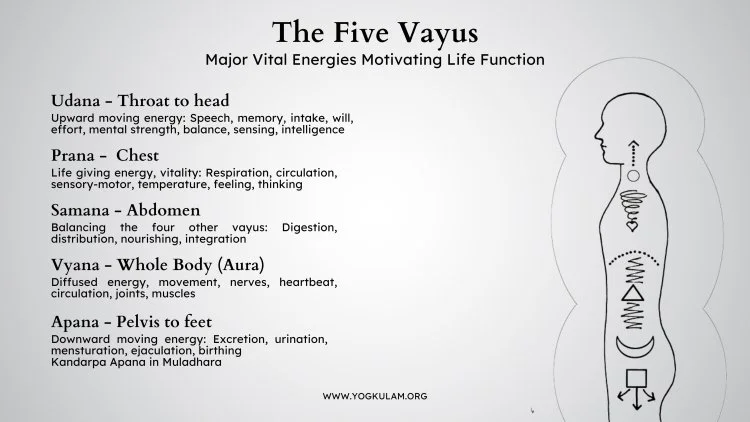Understanding Prana Vayu: The Vital Life Force Energy

In the ancient yogic and Ayurvedic traditions, the concept of Prana Vayu holds a central place in understanding how life energy flows within the human body. Derived from Sanskrit, "Prana" means life force or vital energy, and "Vayu" means wind or movement. Together, Prana Vayu refers to the vital air or energy that governs the inward movement of breath and life force throughout the body.
What is Prana Vayu?
Prana Vayu is one of the five major types of vayus (also called pancha vayus), which are the five vital winds or energies that regulate different physiological and subtle functions in the body. While each vayu controls specific aspects of life, Prana Vayu is particularly associated with the inhalation process, intake of nutrients, sensory perception, and the overall reception of energy from the environment.
Located primarily in the chest, throat, and head region, Prana Vayu directs the flow of energy inward, drawing air into the lungs during breathing and supporting vital organs like the heart and brain. It is responsible for maintaining alertness, mental clarity, and emotional stability.
The Role of Prana Vayu in Breath and Energy
Breathing is the most direct manifestation of Prana Vayu. When we inhale, Prana Vayu draws in oxygen, which fuels every cell in the body. This inward movement of energy not only sustains physical life but also nourishes the mind and spirit. Practicing mindful breathing techniques such as pranayama can help regulate Prana Vayu, leading to increased vitality and mental focus.
In yogic practices, the control and balancing of Prana Vayu are fundamental. When Prana Vayu flows freely and harmoniously, it promotes a sense of well-being, clarity, and calm. However, an imbalance or blockage in Prana Vayu can lead to issues such as anxiety, respiratory problems, and fatigue.
How to Balance Prana Vayu
Balancing Prana Vayu involves nurturing the inward flow of life energy. Here are some key practices:
-
Pranayama (Breath Control): Techniques like Nadi Shodhana (alternate nostril breathing) and Ujjayi breath help regulate Prana Vayu, ensuring smooth and steady breath.
-
Meditation and Mindfulness: These practices calm the mind and support the free flow of Prana Vayu by reducing mental chatter and stress.
-
Physical Exercise: Gentle exercises such as yoga asanas open up the chest and enhance lung capacity, supporting Prana Vayu.
-
Healthy Diet: Consuming fresh, sattvic foods nourishes the body and mind, supporting the vitality of Prana Vayu.
Prana Vayu and Holistic Health
In Ayurveda, Prana Vayu is closely linked with overall health and longevity. Because it governs the intake of oxygen and sensory input, it is fundamental to both physical and mental well-being. Disruptions in Prana Vayu can manifest as shortness of breath, confusion, or emotional disturbances.
By paying attention to the flow of Prana Vayu through breath awareness and lifestyle choices, one can improve energy levels, mental clarity, and emotional balance. This holistic approach integrates body, mind, and spirit for optimal health.
- Art
- Causes
- Crafts
- Dance
- Drinks
- Film
- Fitness
- Food
- Games
- Gardening
- Health
- Home
- Literature
- Music
- Networking
- Other
- Party
- Religion
- Shopping
- Sports
- Theater
- Wellness


